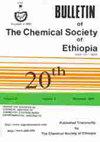Magnetic coffee residue biosorbent for selective extraction of zinc oxide nanoparticles in water samples
IF 1.3
4区 化学
Q3 CHEMISTRY, MULTIDISCIPLINARY
引用次数: 1
Abstract
ABSTRACT. Quantification of engineered nanomaterials in the environment has attracted researchers’ interest recently because of their increased release to the environment. In this study, a recyclable and easily accessible magnetized coffee residue (MCR) is proposed for magnetic solid-phase extraction (MSPE) of zinc oxide nanoparticles (ZnO-NPs) from water samples. The MCR was synthesized using a simple one-step chemical co-precipitation method from coffee residue and was characterized by state-of-the-art techniques. Various parameters affecting the MSPE efficiency of ZnO-NPs were optimized and 8.5 pH, 75 mg adsorbent, 120 min extraction time, 10 mL sample volume, 4 mL of 0.001 M HCl as an eluting solvent, and 30 min elution time were identified as the optimum conditions. Under these conditions, the method showed excellent linearity (R2 = 0.995) and good sensitivity (detection limit, 0.12 mg L-1, and quantification limit, 0.4 mg L-1). Intra and inter-day percent standard deviations were 1.4 and 2.2%, respectively, for the analysis of 6 mg L-1 ZnO-NPs. The practical applicability of the method for the extraction of ZnO-NPs in environmental samples was evaluated, and recovery values in the range of 93.0–98.2% were obtained, confirming its successful performance. Generally, the technique is easy, economical, and eco-friendly that can be considered for the extraction of metal oxide nanoparticles. KEY WORDS: Zinc oxide nanoparticles, Magnetic coffee residue, Magnetic solid-phase extraction, Flame atomic absorption spectroscopy, Environmental waters Bull. Chem. Soc. Ethiop. 2023, 37(4), 859-873. DOI: https://dx.doi.org/10.4314/bcse.v37i4.5磁性咖啡渣生物吸附剂选择性提取水中氧化锌纳米颗粒
摘要。工程纳米材料在环境中的量化最近吸引了研究人员的兴趣,因为它们向环境中的释放增加了。在本研究中,提出了一种可回收且易于获得的磁化咖啡渣(MCR),用于从水样中磁性固相提取氧化锌纳米颗粒(ZnO NP)。采用简单的一步化学共沉淀法从咖啡渣中合成了MCR,并用最先进的技术对其进行了表征。优化了影响ZnO NPs MSPE效率的各种参数,确定8.5 pH、75mg吸附剂、120min提取时间、10mL样品体积、4mL 0.001M HCl作为洗脱溶剂和30min洗脱时间为最佳条件。在这些条件下,该方法显示出良好的线性(R2=0.995)和良好的灵敏度(检测限为0.12 mg L-1,定量限为0.4 mg L-1)。对于6 mg L-1 ZnO NP的分析,日内和日间百分比标准偏差分别为1.4%和2.2%。评估了该方法在环境样品中提取ZnO纳米粒子的实际适用性,回收率在93.0-98.2%之间,证实了其成功性能。一般来说,该技术简单、经济、环保,可用于提取金属氧化物纳米颗粒。关键词:氧化锌纳米颗粒,磁性咖啡渣,磁性固相萃取,火焰原子吸收光谱,环境水公牛。化学。Soc.Ethiop。2023,37(4),859-873.DOI:https://dx.doi.org/10.4314/bcse.v37i4.5
本文章由计算机程序翻译,如有差异,请以英文原文为准。
求助全文
约1分钟内获得全文
求助全文
来源期刊
CiteScore
2.20
自引率
8.30%
发文量
113
审稿时长
6-12 weeks
期刊介绍:
The Bulletin of the Chemical Society of Ethiopia (BCSE) is a triannual publication of the Chemical Society of Ethiopia. The BCSE is an open access and peer reviewed journal. The BCSE invites contributions in any field of basic and applied chemistry.

 求助内容:
求助内容: 应助结果提醒方式:
应助结果提醒方式:


